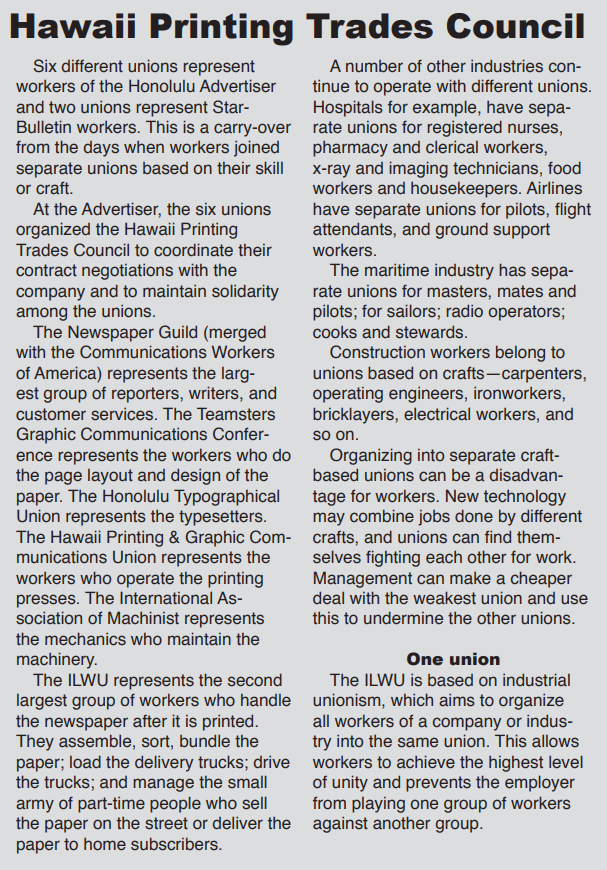Over 900 employees of Honolulu’s two daily newspapers have no idea if they will have a job. The people who write the news became the news when they learned about their fate in a press release issued by their employers.
On Feb. 25, 2010, Gannett Company and Oahu Publications, Inc. (OPI) announced in a joint press release that The Honolulu Advertiser would be sold to OPI, a company controlled by David Black. Black’s company already owns the Honolulu StarBulletin, which it purchased in 1991, and the Mid-Week Magazine.
Star-Bulletin up for sale
Federal anti-trust law prohibits common ownership of competing daily newspapers. This means David Black must either sell the StarBulletin, close one of the papers, or merge the papers.
David Black has put the StarBulletin up for sale and intends to merge the two newspapers if no buyer is found. Black plans to close the Star-Bulletin’s Kaneohe operation and move to the Advertiser’s Kapolei plant.
Three offers have been made to buy the Star-Bulletin, but industry insiders suspect Black has no intention of selling the Star-Bulletin and is only going through the motions to satisfy federal regulators.
On March 9, Gannett informed their 600 employees at the Advertiser they would be terminated between April 12 and April 30 when the newspaper is sold. On March 19, Star-Bulletin employees were told about one-half of the employees or 150 workers may lose their jobs around May 19 if the newspapers are merged.
OPI has contracted a management service company to operate the Advertiser during the transition after Gannett leaves.
OPI has contracted a management service company to operate the Advertiser during the transition after Gannett leaves.
U.S. laws weak on worker protection
The owners of both newspapers made their decisions without talking to their employees.
Such action by management would be illegal in the European Community where workers have the right to information about their employer’s financial condition. Employers must also consult with their workers on matters that affect employment.
European workers would have been informed well in advance of any decision and would have the right to negotiate with their employer to find alternatives to prevent and limit layoffs or closures.
The intent of the European law is to maintain fairness in economic relations between employers and employees, to provide some security for employees, and to guard against exploitation.
In the U.S., employers are only required to give workers 60 day’s notice of a layoff or closure. The intent of the U.S. law is to give workers time to prepare for their job loss and not so workers can challenge their employer’s decisions.
If their workers are unionized, U.S. employers have a duty to negotiate with the unions on how the layoff or closure will be carried out.


A dozen of these floating cranes in the middle of Victoria Harbor off the Island of Hong Kong transfer shipping containers from freighters to barges. Midstream operations where cargo is moved between two ships at sea avoids the high fees charged by the Hong Kong container port but can be dangerous and risky.
European Charter gives workers right to information & consultation
The right to information and consultation are basic workers’ rights recognised at the national, European Community and international levels.
They involve in particular the right to be informed and consulted on their employer’s economic and financial position; on decisions likely to have an effect on employment within the company; and the right to recognition of the ‘works council’
This right is based on the promotion and implementation of ‘social dialogue’ as set out in Articles 138 and 139 of the European Charter.
The justification for rights to information and consultation is the importance of maintaining fairness in economic relations between employer and employee. In particular the sharing of information provides a degree of security for employees as well as an important check against exploitation.
Similarly, a modern forwardlooking business does not keep its workers in the dark about important decisions affecting them. It is not acceptable, for instance, for workers to learn from the media for the first time that they are going to lose their jobs.
Shipping volume jumps 32%
A Bloomberg survey in February 2010 reported a huge 32 percent jump in shipping charters in December 2009. As orders for their products return to normal levels, manufacturing companies are replenishing their supply of raw materials.
Demand for coal and iron-ore are so strong that ships must wait in long lines to pick up their cargo. At the Port of Newcastle in Australia, as many as 55 ships are waiting to load coal, compared with 17 a year ago. Similar lines are forming at the iron-ore ports of Tubarao in Brazil and Qingdao in China.
Last year, shipping was so slow that the South Korean Port of Busan had to find space to store 31,000 empty containers. Today, the containers are full and waiting to be shipped to the US and Europe, but there aren’t enough ships to carry the increasing loads.
One of the reasons for the shortage of ships is the growing number of last minute rush orders. US retailers had cut their inventories to the lowest level in two years and are now placing rush orders to restock.
With little advance notice, container ships must be moved to ports where they are needed, which can take several days.

